

Single stellar images were taken to show the diffraction rings in the Airy pattern, for various size apertures. Where appropriate, the images were scaled up in brightness to show the very dim rings. The diameters and intensities of the rings were always compared with the theoretical predictions, and always matched within some small error bars. Short exposures were always taken to avoid saturating the central core, allowing quantitative measurements to be taken.
Images of double stars and stellar fields were taken to show the wide dynamic range possible in CCD cameras, especially when used at very large focal lengths. Various size apertures have been used. Where appropriate, the images were scaled up in brightness to show the very dim companions. Short exposures were always taken, to prevent saturating the brighter component.
Multiple stellar images were taken during planetary imaging runs to show the seeing. Combined into short movies, they show typical seeing on various nights.
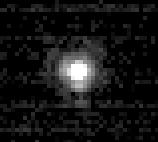
Alcyone, December 29, 1999, single 0.1 second exposure, SBIG ST-7, CFW8 red filter, 9.5" Newtonian telescope, lens projection to F/59 (14.2 meter effective focal length), pixels binned 2x. No PEC or image stabilization used, since the exposure was too short and the target was too dim. Seeing was good, but not spectacular; the exposure was simply one of several images used for test purposes during some calibration runs. When the individual pixels in the raw image are plotted in cross-section, the full-width at half-maximum is seen to be about 3 pixels, equivalent to 0.8 arcseconds. The first and second diffraction rings are also seen, when scaled and stretched, as shown in the jpg image above.
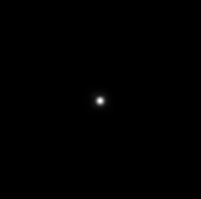
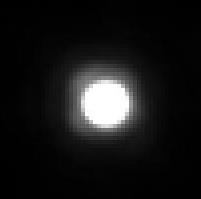
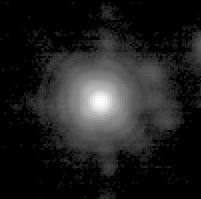
Betelgeuse (alpha Orionis) January 15, 2000. On a night when the seeing was not good enough to take planetary images, experiments with a stopped-down telescope were done. This is an average of three 4 second long exposures taken through a red filter with the 9.5" Newtonian telescope stopped down to 4", SBIG ST-7, and CFW-8 filter wheel. The AO-2 was used to stabilize the images, since Betelgeuse is bright enough for it to work. Comparable images with the AO-2 turned off show only a hint of the first diffraction ring. The first image is the linear scaling, no stretching. The middle frame shows the same image stretched in size (4x) and amplitude, to show the first diffraction ring, saturating the core. Individual pixels are seen (each pixel=0.26 arcsec). The final frame shows the same image stretched logarithmically in amplitude, and 2x in diameter. The Airy pattern rings out to the fifth ring is partially seen!
Sabik (eta Ophiuchi) at 40 degrees altitude August 18, 2001

This close double was near Mars, and was used to focus the CCD camera. I took 300 images, but the turbulence was pretty bad on this very hot day, so only a few images showed the pair. This 0.2 sec exposure through a green filter was the best image. According to the Washington Double Star Catalog, the current separation is about 0.5 arcsec with magnitudes 3 and 3.27. Taken at 40 degrees altitude (the same altitude Mars will appear in 2003), it shows acceptable resolution. At 30 degrees altitude (Mars current altitude), this pair would be completely inseparable. At 50 degrees, more of the images would have been acceptable. This image was processed with maximum entropy processing in MaximDL to help increase the contrast (alternately, processing the raw image with unsharp masking produced a near identical image).
M13 core at F/60, July 28, 2001
(positive and negative)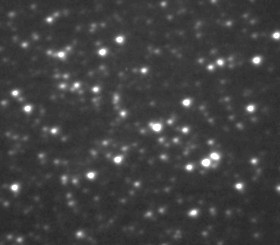
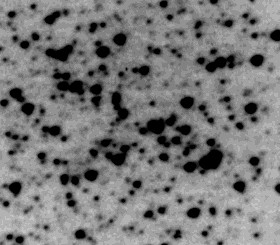
Since Mars was not very interesting in 2001, I decided to try imaging M13, the globular cluster in Hercules, with the same ST-7E CCD setup. While I could not see any stars in the finder, single 10 second exposures through a clear (IR-block) filter showed that my pointing was correct. 100 images were taken with the 9" telescope at F/60, and the best 54 that showed the least image blur were added to make an equivalent 9 minute exposure. (The blurring was due to telescope tracking errors, since no kind of image stabilization or tracking was used.)
The brightest stars are probably around 12th magnitude, while the dimmest stars are probably around 15th magnitude. I've used an M13 image by Ed Henry to help orient the image, and find that it is fairly close to the center of the cluster. North is up, increasing RA is to the left in this image. The width of the image is about 70 arcsec. The bright pair of stars located about halfway to the lower right corner (starting from the center) are separated by about 2.6 arcsec. The upper star in this pair is actually two stars separated by about 0.71 arcsec. These are just resolved when the image brightness is reduced below saturation. More dim stars are seen in the negative image, which is stretched just a bit more.
M13 Mosaic
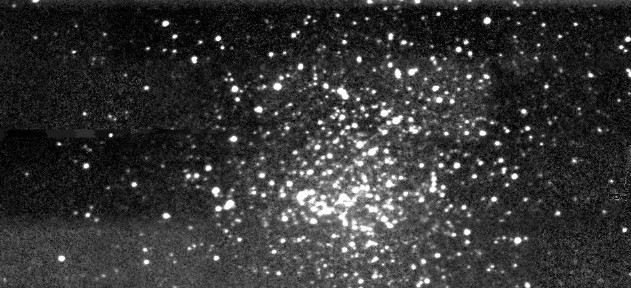
A series of M13 sections, each at F/60 (about 1 arcminute field of view). Each image is composed of 3 exposures of 30 seconds through a visible (IR-blocking) filter. A total of 24 sections were combined into the image above. The overlap is not perfect, and the background changes between rows, but it was produced only as an exercise in mosaicing at high resolution. While the depth is not as good as the central image above, the resolution is identical everywhere.
Marfic (lambda Ophiuchi)
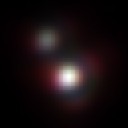
On July 21, 2001, the dust storm on Mars continued to hide any details. I started taking some calibration images for my clock drive, and accidentally slewed to this double star (the nearest bright star near the meridian and near the celestial equator, at the time). Not knowing exactly which star I was imaging, I took a number of 1 second exposures through each of the three color filters. The seeing was pretty good, and diffraction rings seemed pretty stable. I selected the best couple images at each color, combining them for the above image. The double was finally identified by searching through the Washington Double Star Catalog (my copy of (1964) Norton's star atlas has values so old, I didn't recognize the star). The values from that Catalog: separation 1.4 arcsec, magnitudes 4.17/5.22, position angle 29 degrees, all precisely in agreement with the image. The image here shows the brightest component just saturated; the red outline is because the diffraction ring for red is larger than the diffraction ring for green and blue. In the original color images, the rings are better defined for each wavelength. The diameter of the star is just that predicted for a 9" aperture; 0.5 arcsec FWHM in the green.
The Double-Double in Lyra just fits into the ST-7 CCD when used at F/15. A green filter was used to reduce any possible chromatic aberration due to the barlow lens. The larger image shows the entire frame, compressed in jpg format. To view the separate components, each part of the frame was expanded and shown below. In all the images, the stars were slightly saturated to better show them; the original images were not saturated in this 1 second exposure.
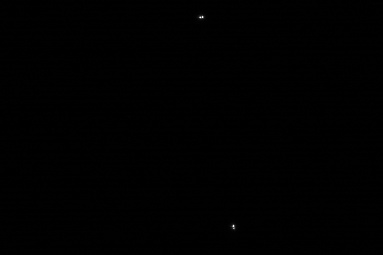
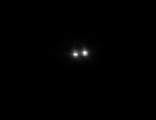
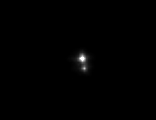
In the February 2000 issue of Sky and Telescope magazine, two interesting articles on Orion are included. One article on pages 93-94 highlights the Trapezium. The other article on pages 111-115 gives a list of double stars in Orion. On a night when the seeing was not good enough to take images of Jupiter or Saturn, I tried imaging some of these brighter doubles. A link to the Trapezium images is shown above. Those images were taken with the full 9.5" aperture, using an SBIG ST-7 and CFW-8 combination through a turned-off AO-2 system. The Rigel image below was taken during some experiments with the telescope stopped down with a 100 mm off-axis mask. This mask eliminates the spider diffraction while using only a small, high-quality portion of the mirror. The focus was done at full aperture, so the focus error is negligible with the mask.
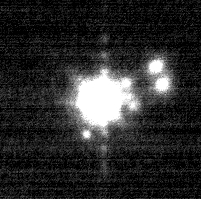
Rigel, January 15, 2000. Five images, each 4 seconds long, through the red filter, were combined and stretched to show the companion star at 9.5 arcseconds to the lower left. The magnitude difference between the primary and secondary stars is 6.9, or a ratio of about 600:1. Longer exposures would have saturated the primary star. Because of the great difference in the brightness, other artifacts are seen; the four "stars" to the right are reflections (unknown source), for example. The rings around the star are diffraction rings. How can I be sure of the companion? I took a reference image of Betelgeuse, and subtracted them after normalizing to the same peak intensity.
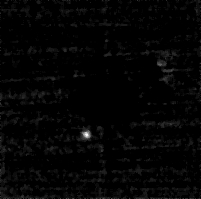
This is the same image, with the Betelgeuse image subtracted. All that remains is Rigel's companion!
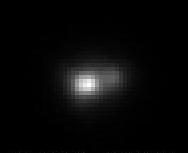
eta Orionis, January 2, 2000, with 9.5" aperture, effective focal length 14.2 m, clear filter, 0.5 second exposure. This is the only good image, the rest spoiled by seeing. The image is expanded by a factor of four to show the individual pixels at 0.26 arcsec/pixel. The separation should be 1.5 arcsec (about 6 pixels), but there is a little blurring to about 1.8 arcseconds (about 7 pixels). Tthe difference between the stars of one magnitude (2.5x ratio) makes it easy to show both stars without intensity stretching.
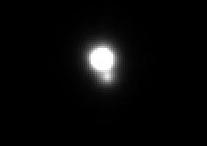
zeta Orionis, January 2, 2000, with 9.5" aperture, effective focal length 14.2 m, clear filter, combined 3 images, each a 0.8 second exposure. This is the longest exposure that would not saturate the brighter star. The image is expanded 2x dimensionally. To show the dimmer star, I had to saturate the brighter star in this jpeg image. The separation is 2.4 arcseconds, but the wide brightness separation of 2.1 magnitudes (7x) makes it more challenging to separate.
All text and images are owned by Stellar Products, 1992-2003. Any use by others without permission of Stellar Products is prohibited.
Return to the Image Gallery index page
Return to Stellar Products home page